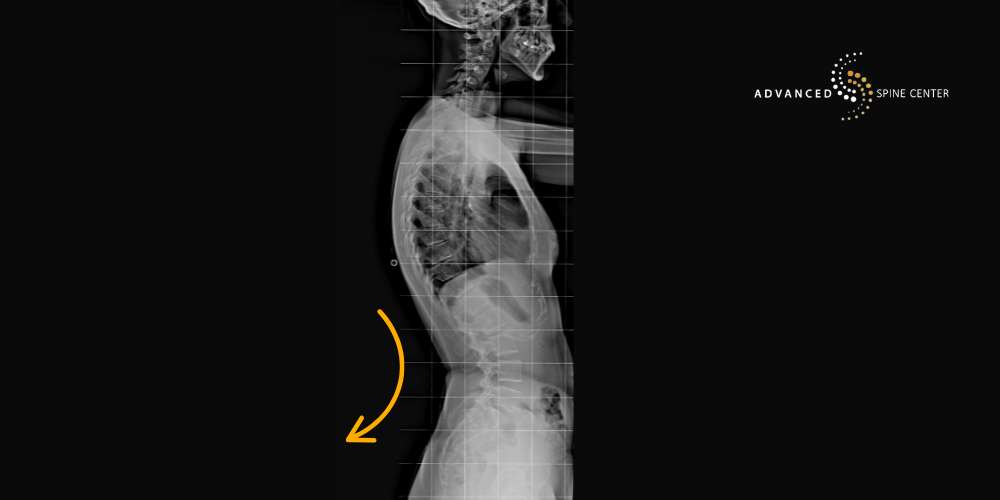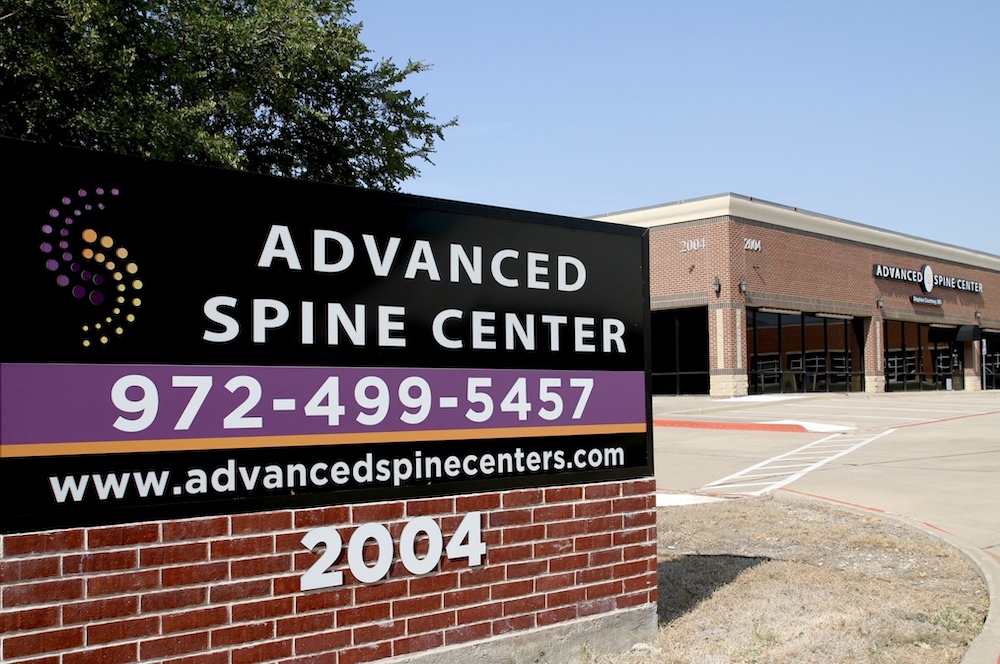Specialties

Maintaining a healthy spine is essential for overall well-being, but conditions like lordosis can disrupt the spine’s normal curve and cause a range of physical symptoms. At Advanced Spine Center, we offer comprehensive lordosis treatment in Plano, TX, to help patients restore their normal spinal contours and reduce pain.
Whether you are experiencing excessive lordosis in the lumbar spine or cervical spine, our experienced team, led by Dr. Stephen Courtney, can accurately diagnose lordosis and create a personalized care plan. Using advanced imaging techniques such as magnetic resonance imaging (MRI) and computed tomography (CT), we assess the severity of your spine curvature and recommend the best course of action, from physical therapy to minimally invasive surgery when necessary.
If you are struggling with symptoms like an exaggerated inward curve, poor posture, or difficulty with range of motion, our specialists are here to help. Contact Advanced Spine Center today at (972) 499-5457 or complete our online form to schedule your consultation and take the first step toward improving your spine health.
What is Lordosis?
An excessive inward curvature of the spine, commonly called lordosis, can affect the lumbar spine, cervical spine, or thoracic spine, leading to discomfort and changes in posture. A normal spine includes gentle curves that help absorb shock and support the body’s weight, but an excessive lordosis can disrupt this balance and lead to an abnormal curvature.
This condition is often recognized by a swayback appearance, where the pelvis tilts forward and the hips are pushed forward. In some cases, lordosis can develop during growth spurts, be associated with poor posture, or occur due to weakened muscles around the spine.
When the condition appears in children without underlying health concerns, it may be called benign juvenile lordosis. In the neck region, an abnormal curve may be called reverse cervical lordosis, impacting the natural shape of the cervical spine.
Lordosis vs. Kyphosis
Lordosis and kyphosis are both conditions involving abnormal changes to the spine’s natural shape, but they affect different regions and curve directions. In a healthy human spine, a slight lordotic curve is normal in the lumbar and cervical spines, helping to maintain balance and absorb shock.
However, when the inward curve becomes too pronounced, it leads to excessive lordosis, creating an exaggerated arch in the lower back or neck. Kyphosis, on the other hand, involves an abnormal outward rounding of the thoracic spine, known as increased thoracic kyphosis, often resulting in a hunched posture. Both an excessive lordotic curve and an extreme outward curve in kyphosis can cause pain, reduced range of motion, and restrict normal movement if not properly treated.
If you are struggling with an excessive inward or outward spinal curve, Advanced Spine Center offers lordosis and kyphosis surgery in Plano, TX, for patients seeking to correct their spinal alignment and support long-term spine health. To learn more about our treatment options for excessive spine curves, call (972) 499-5457 today.
Lordosis vs. Scoliosis
While both lordosis and scoliosis involve abnormal changes to the spine’s natural curve, they are very different conditions. Lordosis refers to an excessive inward curve of the lumbar spine or cervical spine, creating an exaggerated arch in the lower back or neck.
In contrast, scoliosis involves a sideways, or lateral, spine curvature, often forming an “S” or “C” shape when viewed from behind. A normal spine has gentle front-to-back curves like the lordotic curve and the kyphotic curve of the thoracic spine, but scoliosis disrupts this alignment by causing the spine to shift sideways. Both conditions can restrict normal movement, cause discomfort, and, in severe cases, impact the spinal cord or range of motion.
Proper diagnosis through a physical exam, magnetic resonance imaging, or computed tomography is essential for distinguishing between these spinal issues and determining the best approach for lordosis or scoliosis treatment in Plano, TX.
Types of Lordosis
Lordosis can affect different regions of the spine, depending on the location and severity of the excessive inward curve. While a slight lordotic curve in the lumbar spine and cervical spine is a normal part of healthy spine curvature, an exaggerated inward curve in these areas can lead to pain, stiffness, and reduced range of motion.
Cervical Lordosis
Cervical lordosis refers to the natural inward curve of the cervical spine, which supports the head and allows for a normal range of motion in the neck. A healthy lordotic curve in the cervical region helps balance the spine’s curvature and protect the spinal cord.
However, when this curve becomes too deep or flattens out, it can lead to an abnormal condition known as reverse cervical lordosis. In cases of excessive lordosis or a reversed curve, individuals may experience neck pain, stiffness, headaches, and even problems with bowel or bladder control if the spinal cord is compressed.
Lumbar Lordosis
Lumbar lordosis describes the inward curve of the lumbar spine, located in the lower back. A normal lordotic curve supports the body’s weight and allows for proper balance and range of motion. However, when the curve becomes overly pronounced, it results in excessive lordosis, often leading to a noticeable swayback appearance where the pelvis tilts forward, a condition known as anterior pelvic tilt. This abnormal curvature can place additional strain on the spinal cord, tighten the lower back muscles, and restrict normal movement.
What Causes Lordosis?
Several factors can contribute to the development of lordosis and an exaggerated inward curve of the spine. Common causes include poor posture, anterior pelvic tilt, obesity, weakened core muscles, and certain medical conditions that affect bone health, such as osteoporosis or spondylolisthesis.
During childhood or adolescence, rapid growth spurts can also cause temporary changes to the spine’s curvature, sometimes leading to benign juvenile lordosis. In addition, injuries to the lumbar spine or cervical spine, congenital spine disorders, and neuromuscular diseases can all increase the risk of developing an abnormal curve.
Understanding the underlying causes of excessive spine curves is essential for accurately diagnosing and effectively treating lordosis.
Risk Factors for Developing Lordosis
Several risk factors can increase the likelihood of developing an excessive lordotic curve in the spine. People with poor posture, anterior pelvic tilt, or weakened abdominal and lower back muscles are more likely to develop a condition called lordosis. Pregnant women are especially vulnerable due to changes in body weight distribution and posture, which place additional stress on the lumbar spine and pelvis.
Rapid growth spurts during adolescence, particularly when combined with low bone density, can result in conditions like benign juvenile lordosis. Degenerative issues affecting the spinal cord or vertebrae, such as osteoporosis or disc disease, can also alter the spine’s natural curves over time. Additionally, obesity, previous spinal injuries, and certain surgeries can further disrupt normal spinal contours, increasing the risk of an abnormal curve.
Symptoms of Lordosis
The symptoms of lordosis can vary depending on the severity and location of the spine curvature. Mild cases may cause little to no discomfort, while more severe lordosis can lead to noticeable back pain, stiffness, and reduced range of motion.
Individuals with lumbar lordosis often exhibit a swayback appearance, where the pelvis tilts forward and the hips are pushed forward, which affects their overall posture. When the cervical spine is involved, symptoms can include neck pain, headaches, and a forward head position, sometimes linked to a condition called reverse cervical lordosis.
In severe cases, the abnormal curvature may place pressure on the spinal cord, potentially leading to numbness, tingling, or even loss of bowel or bladder control. Some people also experience muscle weakness, fatigue, and difficulty when they bend forward.
How is Lordosis Diagnosed?
Diagnosing lordosis begins with a thorough physical exam by a spine specialist. During the exam, the doctor will assess your posture, check for an excessive inward curve of the lumbar spine or cervical spine, and observe how your spinal curve changes when you stand, sit, or bend forward.
In addition to a physical exam, imaging tests are often used to confirm the diagnosis and evaluate the severity of the spine’s curvature. Magnetic resonance imaging (MRI) and computed tomography (CT) scans provide detailed views of the spinal cord, vertebrae, and surrounding tissues.
These studies help determine if the lordotic curve is putting pressure on the nerves or causing other complications. X-rays are commonly used to measure the angle of the abnormal curve and compare it to normal spinal contours. Early detection through proper imaging and evaluation is critical for accurately diagnosing lordosis and creating an effective treatment plan to maintain spine health.
How is Lordosis Treated?
In many cases, treating lordosis begins with conservative methods to restore normal spinal contours, improve posture, and reduce strain on the spine. For patients with milder cases or early signs of an excessive curve, options such as physical therapy, posture correction, and strengthening exercises can be highly effective. More severe cases of lordosis may require a more advanced approach, including minimally invasive surgery or procedures like artificial disc replacement.
The specific treatment plan depends on the severity of the spine curvature, the patient’s symptoms, and the affected region of the spine, whether it is the lumbar spine, cervical spine, or thoracic spine.
Nonsurgical Treatment Options
For many patients, lordosis treatment starts with nonsurgical methods to improve posture, strengthen the body, and restore a more normal curve to the spine. Physical therapy plays a key role in addressing muscle imbalances that contribute to anterior pelvic tilt and excessive lordosis.
Targeted exercises help strengthen muscles in the core, hips, and lower back, which promotes better spinal alignment and reduces pressure on the spinal cord. Postural retraining, stretching, and lifestyle modifications are also essential for managing pain and preventing further curvature.
These nonsurgical strategies are especially effective for managing benign juvenile lordosis, reverse cervical lordosis, and other mild to moderate abnormal curves without immediately resorting to surgical intervention.
Physical Therapy for Lordosis
Physical therapy is often the first line of defense when treating lordosis. Customized exercise programs are designed to improve posture, enhance flexibility, and strengthen muscles that stabilize the human spine.
Therapy focuses on restoring a healthier lordotic curve while also protecting the normal movement of the lumbar spine, thoracic spine, and cervical spine. Consistent therapy can help reduce pain, prevent the worsening of excessive curvature, and support long-term spine health.
Surgical Options for Excessive Lordosis in Plano, TX
When nonsurgical treatments are not enough, surgical intervention may be necessary to restore proper alignment and protect the spinal cord. At Advanced Spine Center, we offer advanced surgical options for excessive lordosis in Plano, TX, tailored to the severity and location of the spine’s curvature.
Surgery is typically recommended in severe cases where the abnormal curvature causes significant pain, nerve compression, or loss of normal movement. Procedures may involve correcting the spine’s curvature, decompressing pinched nerves, and stabilizing the affected area to preserve spine health.
Artificial Disc Replacement for Lordosis
Artificial disc replacement is an effective surgical option for patients with cervical lordosis or lumbar lordosis linked to degenerative disc disease and a disrupted lordotic curve. During the procedure, the damaged disc that is contributing to the abnormal curvature is removed and replaced with an artificial implant designed to mimic the movement and cushioning of a healthy disc. This allows the spinal curve to be restored without sacrificing range of motion, preserving more natural movement compared to traditional spinal fusion.
At Advanced Spine Center, artificial disc replacement surgery in Plano, TX, can help correct a reversed cervical lordosis and relieve pressure on the spinal cord, ultimately improving posture, reducing pain, and promoting better spine health.
Spinal Fusion for Lordosis
In more severe curves where the spine’s curvature becomes extreme or unstable, spinal fusion may be necessary to restore balance and protect the spinal cord. Spinal fusion involves permanently connecting two or more vertebrae using bone grafts and spinal instrumentation such as rods, plates, and screws.
At Advanced Spine Center, cervical spinal fusion surgery in Plano, TX, is performed to correct issues like reverse cervical lordosis, relieve nerve compression, and stabilize the neck region. In cases of severe lumbar lordosis, lumbar spinal fusion surgery may be used to realign the lower back and prevent further curvature or spinal instability.
While fusion procedures may slightly limit range of motion, they are highly effective at improving posture, reducing pain, and supporting long-term spine health. To learn more about how cervical and lumbar fusion surgery in Plano, TX, can help treat lordosis, contact Advanced Spine Center today.
Lordosis FAQs
When is Surgery Necessary for Treating Lordosis?
Surgery for treating lordosis is generally necessary when the excessive curvature causes severe pain, compresses the spinal cord, or significantly restricts normal movement. It may also be recommended when nonsurgical treatments like physical therapy fail to correct the abnormal curve or when the condition threatens long-term spine health.
Can Lordosis Get Worse Without Treatment?
Yes, without proper lordosis treatment, the excessive inward curve can worsen over time, leading to increased pain, reduced range of motion, and greater pressure on the spinal cord and surrounding structures. Ignoring an abnormal curvature can also cause further spinal instability and make future treatment more complex.
Can Physical Therapy Help Treat Lordosis?
Yes, physical therapy is often a highly effective approach for treating lordosis, especially in mild to moderate cases. Targeted exercises can strengthen muscles, correct anterior pelvic tilt, improve posture, and help restore a more natural curve to the spine, which can reduce pain and prevent further curvature.
Contact the Advanced Spine Center for Lordosis Treatments in Plano, TX
If you are noticing signs of excessive lordosis or changes in your spinal curve, the team at Advanced Spine Center is here to help. Our experienced spine specialists offer advanced options for lordosis treatment to restore your normal spine function and improve your quality of life.
From physical therapy to minimally invasive surgery, we provide personalized care to address every level of severity. Call Advanced Spine Center today at (972) 499-5457 to schedule your consultation for lordosis treatment in Plano, TX, or visit our website to schedule an appointment.


